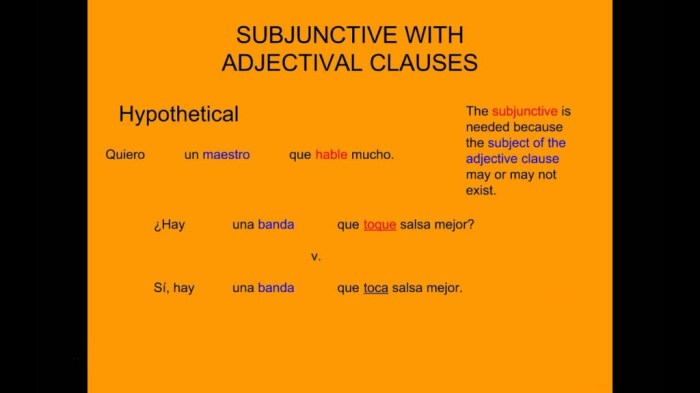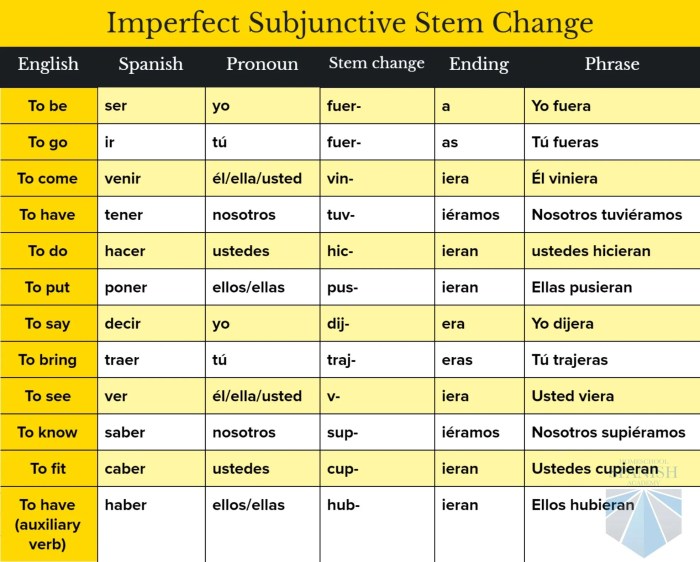Subjunctive in adjective clauses spanish examples – Embark on an exploration of the subjunctive mood in Spanish adjective clauses, a grammatical realm where precision and nuance intertwine. Delve into the intricacies of this grammatical construction, uncovering its purpose, usage, and the specific conditions that necessitate its employment.
Through a tapestry of illustrative examples, we will unravel the different types of adjective clauses that demand the subjunctive mood, delving into the intricacies of verb conjugation in the present, past, and future subjunctive tenses. Along this linguistic journey, we will uncover common expressions that naturally lend themselves to the subjunctive mood within adjective clauses, shedding light on their contextual usage.
Subjunctive Mood in Adjective Clauses: Subjunctive In Adjective Clauses Spanish Examples

In Spanish, the subjunctive mood is used in adjective clauses to express uncertainty, possibility, or emotion. It is often used after verbs like querer(to want), desear(to desire), esperar(to hope), and temer(to fear).
When the subjunctive is used in an adjective clause, it indicates that the information in the clause is not factual or certain. Instead, it expresses the speaker’s opinion, desire, or emotion.
Types of Adjective Clauses Using the Subjunctive Mood, Subjunctive in adjective clauses spanish examples
- Adjective clauses of desire or intention:These clauses express the speaker’s desire or intention for something to happen. They are typically introduced by que(that) and use the present subjunctive.
- Adjective clauses of doubt or uncertainty:These clauses express the speaker’s doubt or uncertainty about something. They are typically introduced by que(that) or si(if) and use the present subjunctive.
- Adjective clauses of emotion:These clauses express the speaker’s emotion or reaction to something. They are typically introduced by que(that) and use the present subjunctive.
Conjugation of Verbs in the Subjunctive Mood
Verbs in the subjunctive mood are conjugated differently than verbs in the indicative mood. The present subjunctive is formed by adding the following endings to the verb stem:
| Person | -ar Verbs | -er/-ir Verbs |
|---|---|---|
| Yo | -e | -a |
| Tú | -es | -as |
| Él/Ella/Usted | -e | -a |
| Nosotros/Nosotras | -emos | -amos |
| Vosotros/Vosotras | -éis | -áis |
| Ellos/Ellas/Ustedes | -en | -an |
Popular Questions
What is the purpose of the subjunctive mood in Spanish adjective clauses?
The subjunctive mood in Spanish adjective clauses conveys a sense of uncertainty, possibility, or subjectivity, often expressing the speaker’s opinion or emotional state rather than an objective fact.
When is the subjunctive mood required in adjective clauses?
The subjunctive mood is generally required in adjective clauses introduced by the conjunctions “que” (that) and “quien” (who), when the main clause expresses an emotion, opinion, doubt, or uncertainty.
How do I conjugate verbs in the subjunctive mood?
Verb conjugation in the subjunctive mood follows specific rules that vary depending on the tense and the verb group. Generally, the present subjunctive is formed by dropping the infinitive ending and adding “-e” for regular verbs and “-a” for irregular verbs.


